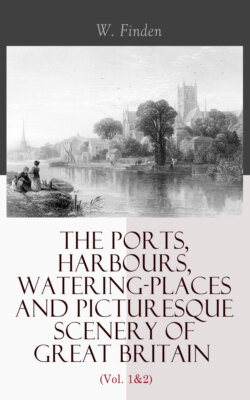Читать книгу The Ports, Harbours, Watering-places and Picturesque Scenery of Great Britain (Vol. 1&2) - W. Finden - Страница 29
На сайте Литреса книга снята с продажи.
BAMBROUGH CASTLE.
FROM THE SOUTH-EAST.
ОглавлениеTable of Contents
Sir Walter Scott, in his description of the voyage of the abbess of Whitby and her nuns to Holy Island, in the second canto of Marmion, thus speaks of them as noticing Bambrough Castle:
"Thy tower, proud Bambrough, marked they there,
King Ida's castle, huge and square,
From its tall rock look grimly down,
And on the swelling ocean frown."
The view which Balmer, with his usual effect, has given of Bambrough Castle from the south-east, is that which the reverend mother and her five fair nuns might be supposed to contemplate on entering the channel between the Great Farn Island and the mainland, and when about half a mile from the shore. The stranded vessel, however, must not be supposed to be of the age of Henry VIII., when the abbess made her voyage; for she is evidently a light collier of the present day, whose captain, probably, in running for Skate Roads in a strong south-east gale, had stood too close in shore in passing through the Fareway, and laid her snugly up on Bambrough Sands. The Holy Island fishing-boats that are seen—for no fishermen dwell at the village of Bambrough—would seem to indicate that their owners expect a job in assisting to get her off.
These hardy and industrious men follow an occupation in which the hazards and dangers are but poorly recompensed by their gains; and the sums they occasionally obtain from the owners of colliers and other coasting vessels, form rich prizes in the humble lottery of their life. Having in our remarks on "Bambrough, from the north-west," described the principal features of this sea-girt fortress, we cannot better employ the present page than in a notice of the fishery which is carried on in its vicinity. The boats principally used for this purpose are called cobles, and their fishing ground is from eight to sixteen miles from the shore. In winter, however, they do not venture so far out as in summer, but usually shoot their lines between six and ten miles from the shore. There are usually three men to a coble. When the wind is not favourable and they cannot set their sail, they use their oars; the two men seated nearest the head of the boat row each a single large oar, while the man on the thwart nearest the stern rows a pair of smaller size. The fish are not caught, as on some parts of the south-western coast of England, by hand-lines, which are suspended over the side of the boat, and pulled up when the fisherman feels that he has a bite. The mode of proceeding is to make fast a number of lines together, and shoot them across the tide; and after they have lain extended at the bottom of the sea for several hours—usually during the time of a tide's ebbing or flowing, that is about six hours—they are hauled in. While the lines are shot, one man keeps a look-out, and the other two usually wrap themselves in the sail, and go to sleep in the bottom of the coble. Each man has three lines, and each line is from 200 to 240 fathoms long. The hooks, of which there are from 240 to 300 to each line, are tied, or whipped, as the fishermen term it, to lengths of twisted horse-hair called snoods; each snood is about two feet and a half long, and they are fastened to the line at about five feet apart. Each man's lines, when baited, are regularly coiled upon an oval piece of wicker work, something like the bottom of a clothes-basket, called by the Yorkshire fishermen a skep, at Hartlepool, in the county of Durham, the same thing is called a rip. In this mode of fishing the hooks are all baited, generally by the fishermen's wives and children, before the coble proceeds to sea. The lines when shot are all fastened together; and when each is 240 fathoms long, the length of the whole is nearly two miles and a half. There is an anchor and a buoy at the first end of the line, and the same at the end of each man's set of lines. There are thus four anchors and four buoys to each coble's entire line. The buoys at the extremities of the line are usually formed of tanned dog-skin, inflated in the manner of a bladder, and having a slight pole, like the handle of a mop, passing through them, to the top of which a small flag is attached to render them more conspicuous. The intermediate buoys are generally made of cork. The anchors for sinking and holding the lines are mostly large stones; as an iron anchor, with arms like a ship's, is liable to get fast among the rocks at the bottom of the sea, and be lost in consequence of the buoy rope being too weak to force it loose.
BAMBOROUGH. FROM THE NORTH WEST.
